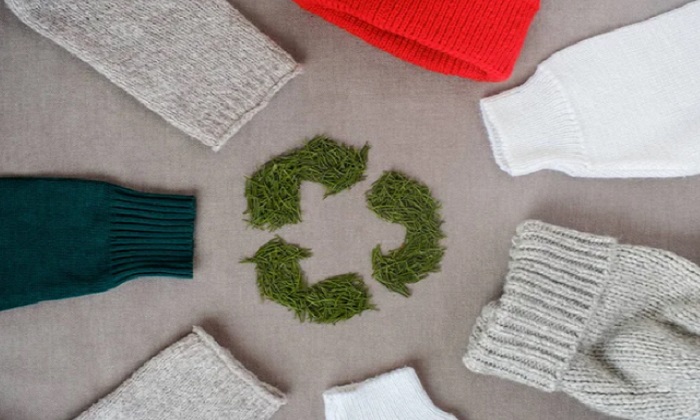The challenges posed by the diverse multitude of fiber types used in apparel production have resulted in the primary exportation of disposed clothing as second-hand garments or downcycling to date. The advancement of technologies for the recycling of apparel into new garments is still in progress.
Closed-loop recycling is a promising approach that numerous nations are currently exploring. This approach is consistent with the global initiative to establish a circular economy, notably in the textile sector. In order to optimize resource efficacy, products are recycled, reused, repurposed, or downcycled in a circular economy. Nevertheless, the industry’s potential for circular practices is largely unrealized as a result of inadequate government support and investment.
However, circular textile recycling initiatives have been initiated by a few companies and organizations worldwide. For example, circular economy principles are being implemented by organizations in Los Angeles through customized programs and staff training that have been devised with the assistance of consultants. The efficacy of these methods is being evaluated through life cycle analyses, as other apparel companies are also investigating comparable strategies. The methods employed by these organizations are briefly summarized below.
All about the closed-loop recycling method
Closed-loop recycling is a sustainable production method that prioritizes the utilization of materials and components obtained from recycling collections or take-back initiatives. It is essential to preserve the quality of the apparel in closed-loop recycling to guarantee that the output produced by the recycled garments is of the same quality as the original input
Although successful trials have been conducted predominantly for polyester garments, which account for a substantial fraction of the global fiber composition, there are still obstacles to the production of wholly recycled garments. Certain manufacturers recycle post-consumer refuse components into new garments. Nevertheless, no single company or nation has yet to devise a failsafe solution for the production of fully recycled garments
W2W or the Wear2wear loop method
The initiative entails the collaboration of the most prominent European brands throughout the textile value chain to manufacture apparel from recycled textile materials. The technology incorporates all the principles of sustainability, such as transparency and traceability. The cyclical nature of the clothing is guaranteed by its ability to be fully recycled at the conclusion of its life cycle. The process encompasses all eight components of the textile value chain, including the fiber, laundering, and disposal
The W2W’s production method is only slightly distinct from the linear production of apparel, as indicated by a life cycle analysis of the method. The linear method necessitates the direct utilization of petroleum to produce polyester fiber, as the initial stage of production entails the recycling of PET bottles. Despite the fact that it is impossible to conduct a direct comparison between the production systems, the environmental impact is evident. In comparison to the linear approach, the present method reduces environmental contamination by 25% and has an impact on human health of over 50%. The original method’s water consumption is reduced to 45% of its original level, while land use is reduced by 20%.
The use of recycled materials in the process results in a reduction in greenhouse emissions, as it mitigates the wastage and emissions that are generated when virgin materials are employed. The emissions were found to be lower in the W2W than in the linear garment production system at all phases. The methods employed by Wear2wear result in a 33% reduction in greenhouse gas emissions, a 51% reduction in the risk to human health, and an approximate 15% reduction in the burden on land resources. The W2W’s comprehensive analysis demonstrated a substantial reduction in energy and raw material consumption. Nevertheless, it was also noted that the overall energy consumption and the environmental impact are contingent upon the type of fiber that is recycled and the type of apparel.
The analysis of the system has led to the conclusion that it will become more efficient as a result of additional research on the types of materials used and their potential impact on the recycling process of apparel. The recycling methods must be evaluated individually, process by process; comparing them to the linear production method will become ambiguous over time due to the fact that each stage of production is distinct.
At present, the primary focus of recycling methods has been on polyester and cotton fibers, with substantial research and investment being directed toward the sustainable production of polyester fiber and the enhancement of recycling methods. The aggregate proportion of recycled fiber has decreased by 7.9 percent from 9 percent, despite these efforts.
However, ongoing research and pilot projects are designed to investigate the methods by which circularity can be implemented in the apparel production process while simultaneously reducing waste. For instance, the HKRITA is a noteworthy initiative that is actively engaged in the promotion of sustainable practices in the textile industry
Processing from Garment to Garment
The industry is being taken aback by the introduction of a mobile used garments recycling facility by the popular G2G or Garment to Garment, which is manufactured by HKRITA in Hong Kong. At present, this miniature 40-foot container factory is situated in Hong Kong and has been accessible to the public since September 2021. However, this innovation is unique in that it does not engage in the bulk recycling of clothing. The initiative is a prime example of transparency and traceability, which are challenging for companies to achieve, despite its primary objective of educating consumers on the recycling of used apparel. Multiple initiatives are underway at the Hong Kong Research Institute of Textiles and Apparels (HKRITA) to achieve sustainability objectives throughout the value chains. The company has already made a significant stride toward reducing water consumption by utilizing supercritical carbon dioxide in the dyeing process, a method that is claimed by all other companies. However, the G2G offers the additional advantage of enabling consumers to observe the entire procedure
The process outlined by the HKRITA is straightforward and comprehensible to the average person. It does so by providing a visual representation of the process by which the clothing will be recycled and transformed into a new garment. Nevertheless, traceability remains a concern, and recycling is subject to standard terms and conditions. The process is unable to remove fibers such as Lycra, spandex, leather, and clothing with a special coating. The most significant limitation of this entire process is that it is limited to the collection of t-shirts and vests for the purpose of recycling and transforming them into apparel. The subsequent stage is to combine the cloth with lyocell and virgin cotton to enhance the durability of the garment.
However, to what extent is it sustainable? The methodology for ascertaining the origin of those basic materials remains unclear. The recycling procedure is restricted to a specific form of clothing due to the fact that many garments contain a spandex component. The trade of used clothing will be further bolstered in the regions where these facilities are available, as many countries still lack them. Consequently, additional research and collaborative endeavours are necessary to guarantee that the identical closed-loop methodology is implemented for all garments
The textile sector will continue to innovate until a more sustainable and optimistic solution is discovered to guarantee the implementation of the circular economy. However, in order to guarantee the circularity of the textile industry, a global regulatory policy must be established to oversee the transparency of the entire value chain. This appears to be an insurmountable challenge due to the involvement of stakeholders with varying bargaining powers. The solution for companies to become environmentally friendly is not to export used clothing to the least developed countries (LDCs) and implement green labelling, which would undermine their economies. Ultimately, the complete chain of garment recycling remains devoid of accountability, transparency, and traceability. In order to guarantee that all three primary components of sustainable production are met, additional scrutiny and stricter regulations are necessary
What is the efficacy of each of these?
While there have been methods and techniques implemented to embed circularity in the textile value chain, there are numerous variables that have yet to be investigated. In numerous countries, there are inadequate municipal regulations that govern the disposal and further sorting of textile refuse. And some counties continue to significantly rely on the landfill method to dispose of used apparel and textile refuse, despite being unaware of the long-term consequences
Many organizations have attempted to implement the circular loop recycling approach; however, the y have been unsuccessful in closing the loop. Consequently, there is still a significant amount of research that needs to be conducted to reduce the impact of garments produced using the linear method of production and to recycle them into new garments using the technologies that are currently being tested. So far, there has been a significant amount of innovation in the field of polyester garments and fiber. However, the true challenge arises when it comes to recycling garments that are composed of fiber c
omposites. In addition, the garments reach the end of their cycle and are unable to be repurposed. Consequently, additional investigation is necessary to consider the potential for recycling the same apparel through the use of advanced technology
The closed-loop system is not yet operationally effective. While some organizations engage in fiber-to-fiber recycling, the number of organizations that engage in textile-to-textile recycling is exceedingly low. The recycling of apparel that is produced using line arproduction techniques is exceedingly challenging due to the technologies that are currently available. Consequently, the fashion industry must prioritize the availability of circular products from the outset of the production process. In each stage of the manufacturing process, including input, design, and production, it is necessary to strategically utilize only cyclical products. In order to effectively carry out the latter phases of recycling and re-use, it is essential to carefully evaluate and invest in suitable technologies and infrastructure
The supply chain’s components have made commendable efforts; however, the system is plagued by the following deficiencies:
Compilation
The collection efforts are dispersed throughout the value chain. The collection of domestic textile waste is dispersed across the countries. There has been a recent emergence of legislation in Australia, the EU, and the United States that regulates the collection of textile refuse. In addition to the absence of policy actions, there have been inadequate incentives for the collection of textile refuse. Consequently, a significant number of take-back programs or used apparel re-collection programs are discontinued after a specific duration. The absence of adequate sorting facilities and infrastructure necessitates that numerous charities discard the textiles and apparel they have collected into the refuse. Consequently, it is imperative to establish a system that is appropriately organized for the collection of used apparel.
Organizing
In the circularity chain, the process of sorting apparel for recycling presents a multifaceted challenge. The question of whether classification should prioritize fiber type, damage assessment, or a composite method is a topic of ongoing debate. In order to transport garments from collection points to sorting facilities and ultimately to recycling centers, the sorting process necessitates a robust transportation system, substantial infrastructure, and capacity
Inadequate infrastructure frequently impedes the conveyance of sorted apparel to recycling facilities, despite the existence of dedicated sorting systems. Furthermore, the significance of garment labels is emphasized by the labor-intensive process of sifting, which is essential for the identification of materials and the directing of items to the appropriate recycling centers. As a result, it is essential to establish preconditions for apparel classification in order to effectively optimize the recycling process.
Recyclability
The recycling model does not frequently ensure that the apparel is recycled in a closed-loop manner. The life of apparel manufactured using the traditional method and the categories of fibers to be recycled have not yet been determined. Additionally, the high cost and question able quality of closed-loop recycling products have prevented them from achieving the desired sales. For example, mechanical recycling is one of the most costly methods of recycling apparel. This is due to the fact that it necessitates mono-material apparel that is undyed, which results in the sifting and procurement of these materials being costly for recyclers. The method is recognized for its ability to diminish the strength of the fibers, which in turn affects the durability of the apparel. Additionally , the garment generated contains virgin fibers, which renders the production of the apparel both costly and unsustainable. The limitations of mechanical recycling are generally addressed by closed-loop recycling, which primarily generates polyester fibers and other fibers. However, the method is exceedingly costly and necessitates a substantial investment and the ability to sustain it in the long term
The Future
Significant obstacles impede the efficacy of the recycling cycle, despite the existence of extant methods for recycling apparel. In order to resolve this issue, it is necessary to implement a comprehensive set of municipal laws that encourage the appropriate disposal and classification of clothing. Furthermore, governments should provide financial incentives and benefits to companies that implement recycling systems, thereby reducing emissions
At present, recycling methods are fragmented across various regions, and there is an absence of centralized government intervention. Municipalities initiate initiatives, which are subsequently pursued by businesses. Nevertheless, a global initiative is essential to improve efficiency and stimulate innovation. The development of a comprehensive strategy for the recycling and reduction of waste in the apparel industry should be a collaborative effort between governments and corporations. This method will guarantee recycling process cost reductions and long-term efficiency improvements
Innovation will be promoted and recycling costs will be reduced as a result of the increased involvement of a variety of stakeholders, which will encourage additional firms to participate in recycling initiatives. This alignment of interests will improve coordination throughout the supply chain. Ultimately, the circularity process can be accelerated by the adoption of this approach, which is consistent with fundamental economic principles.



































